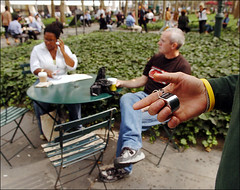The presence of women as an indicator of healthy public spaces
 Keith Bedford for The New York Times. A man and a woman: Minding the gender gap in Bryant Park.
Keith Bedford for The New York Times. A man and a woman: Minding the gender gap in Bryant Park."The City" section of the New York Times has this article about Bryant Park, "Splendor in the Grass" which states:
It was lunchtime at Bryant Park, and thousands of office workers were gathered beneath the emerald veil of trees. Ever since the park was renovated 13 years ago, it has been a remarkable space, and one of its most remarkable aspects is that the number of men and women is about equal, a balance that is carefully monitored as a barometer of the park's health.
In 1980, when the space was rife with drug dealers and other scurrilous sorts, the ratio of men to women was about 9 to 1, said Dan Biederman, president of the Bryant Park Restoration Corporation. But when the park reopened in 1992, the comfort level of women was seen as key to its resurgence, which is why the park's designers paid special attention to accouterments that appeal to women, like bathrooms with full-length mirrors, kiosk food and flowerbeds.
These days, the male-to-female ratio is just about even. And with this balance comes the possibility of triangulation, which Mr. Biederman defines with scientific precision as the tendency of an external stimulus to prompt strangers to interact. "If there's enough triangulation from things in the park," he said, "then people who don't know each other will break down and talk to each other."
To facilitate this mingling, Mr. Biederman and his staff made sure that the park was home to a variety of triangulation objects and events, among them wireless Internet access, chess boards, the carousel, summer movies and an ice skating rink set to open this month.
They must be doing something right. In 2002, the park played host to a party for couples who had met or were engaged or married there; 117 couples celebrated over oysters and crudités.
Here's something I wrote in August about the same issue:
"Prescott to make streets 'women friendly'" from the London Times is a provocative piece that encourages alternative thinking. Almost from the beginning of my involvement in Main Street commercial district revitalization I've made the point that since women conduct upwards of 80% of all retail transactions, unsavory commercial districts aren't likely to thrive.
John King made the same point in an April column about Minneapolis. (Hmm, what is it about Wisconsin and Minnesota anyway?) He starts out the column "Great architecture, clean streets, culture -- it must be Minneapolis" by describing how he saw a woman, obviously comfortable, running by herself late at night.
The ten points King makes dovetail nicely with the ideas and philosophy put forward by the Project for Public Spaces:
1. Street life thrives if you give it a chance.
2. Convenience isn't nearly as convenient as it seems.
3. The more [things to do] the merrier.
4. Culture adds spice.
5. Narrow streets are better than wide ones.
6. Play up the local angles.
7. Good architecture is good architecture, no matter the style.
8. Change is good.
9. Cleanliness counts.
10. Women know best.



0 Comments:
Post a Comment
<< Home